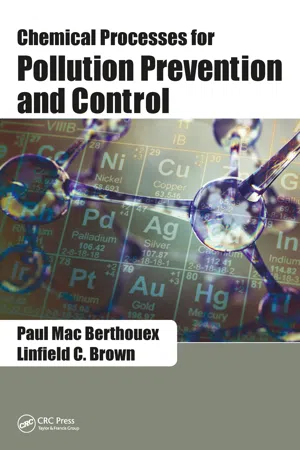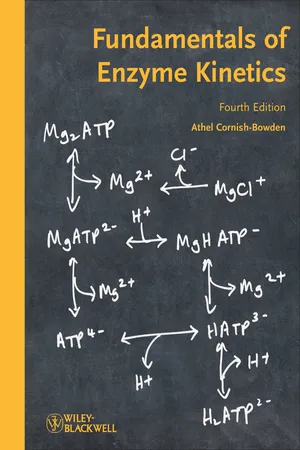Chemistry
pH and pKa
pH is a measure of the acidity or basicity of a solution, with a scale from 0 to 14. A lower pH indicates higher acidity, while a higher pH indicates higher basicity. pKa is the negative logarithm of the acid dissociation constant, which represents the strength of an acid in a solution. It helps predict the behavior of acids and bases in chemical reactions.
Written by Perlego with AI-assistance
Related key terms
10 Key excerpts on "pH and pKa"
- eBook - ePub
Environmental Process Analysis
Principles and Modeling
- Henry V. Mott(Author)
- 2013(Publication Date)
- Wiley(Publisher)
eq ).Given the electrochemical nature of the measurement technique, the measured abundance is in fact the chemical activity of the protons in the solution. We have encountered this chemical activity term earlier and determined that detailed consideration must wait until chapter 10 of this text when we are more fully armed with understandings allowing us to fully appreciate its significance. Thus, for now we will revert to the more familiar definition that pH = −log10 [H+ ] (and the reverse that [H+ ] = 10–pH ), leaving examination and application of the true definition that pH = −log10 {H+ } (−log10 of the molar activity of hydrogen ions) until we embrace the advanced topics of Chapter 10.We could delve into the specific electrochemistry of the pH meter, developing full understandings regarding the bases of the measurement process, but will not. These understandings are published in numerous sources. Although vital to the overall understanding of and refinement of methods for the measurement of pH, assimilating these understandings is beyond the scope of this textbook.Let us examine the hydrogen ion (or proton) in light of the discussion of Chapter 2 relative to the attraction of water to ions in aqueous solution. Once its electron is donated from the hydrogen atom, what remains is the proton situated in the nucleus of the ion with a residual unit positive charge. Then, in aqueous solution, water molecules arrange themselves via short-range bonds between the partial negative of the oxygen and the positive charge of the proton. The first four water molecules tend to orient themselves in a tetrahedral structure. The bonds between the coordinating water molecules and the proton are quite strong. We will leave the computation of the bond energy to the physical chemists. Given that these first four water molecules in no way satisfy the positive charge, additional water molecules are free to orient with the resultant proton–water structure, forming another layer, still strongly bonded to the positive charge, but certainly less so than the inner four. Additional layers of water, each with successively weaker bonds, are added to the overall positively charged ionic structure. In discussions of the relation between the ionic content of water and the activity coefficient (relating molar activity to molar concentration), Dean (1992) lists the ion size parameter (the hydrated radius) of the hydrogen ion as nine angstroms (Å). We can then envision (this works best if we close our eyes and imagine that we can see both the proton and the water molecules) a layered sphere, each layer being a spherical shell, of ordered water molecules surrounding the proton. Within each shell the oxygen atom of each water molecule would tend to be oriented toward the center relative to the hydrogen atoms. Figure 6.1 is a two-dimensional, quite simplistic representation of the general configuration. Given that the water molecules, as a consequence of their innate energy manifest as translational, rotational, and vibrational motion are always on the move, the structure would be dynamic with continual exchange of water molecules. Further, rather than orient in “layers” the water molecules might tend to orient in a much less ordered manner. Regardless of the details, we leave Figure 6.1 - eBook - ePub
- Professor Rob Beynon, J Easterby(Authors)
- 2004(Publication Date)
- Taylor & Francis(Publisher)
Chapter 2 . The equation now simplifies to:pH = pK a+log 10[A −][ HA ]◊ In words: ‘The pH of a solution of a weak acid or base is given by the pKa plus the log (base 10) of the ratio of the concentrations of base to acid.’This is the Henderson–Hasselbalch equation. In the general equation written above, the species HA is the acid (a proton donor) and the species A– is the proton acceptor (a base). The general form written above is not particularly convenient, because it implies that the conjugate base always carries a negative charge, when what we really mean is that it has lost a proton relative to the conjugate acid, and thus, has decreased its charge by 1. Certainly this is true for a simple system like acetic acid, in which acetic acid is neutral and acetate has a charge of −1. For Tris, however, the base is neutral and, thus, when it picks up a hydrogen ion it must acquire a charge of +1. The acidic species in Tris has a charge of +1. It is therefore preferable to think of the Henderson–Hasselbalch equation in more general terms that will suit all cases:pH = pK a+log 10[ base ][ acid ]For acetic acid and Tris, the pKa values are already defined by the value of Ka and, thus, we can substitute for the pKa value in the equation. For acetic acid:and for Tris:pH = 4.76 +log 10[]CH 3COO −[]CH 3COOHpH = 8.1 +log 10[ Tris ][TrisH +]◊ This is why the Ka values were given in exponential form, as 10–4.76 M and 10–8.1 M, on the previous page. Knowing logarithms, it is easy to see that:log 10(= − 4.76 and , therefore , −10)− 4.76log 10(= 4.7610)− 4.76This relationship is of fundamental importance to an understanding of buffer action. It says, simply and clearly, that the pH of a solution is controlled by two factors; the relative concentrations of acid and base, and the pKa - eBook - ePub
- David G. Watson(Author)
- 2020(Publication Date)
- Elsevier(Publisher)
For instance, in a 0.1 M solution of ammonia (K b = 1.8 × 10 − 5), the equilibrium can be written as follows: If the concentration/activity of water is regarded as being 1, then the equilibrium constant is given by the following expression: The concentration of NH 3 can be regarded as being unchanged by a small amount of ionization, and the expression can be written as: In comparison, the pH of 0.1 M NaOH is 13. Self-test 2.2 Calculate the pH of the following solutions: (i) 0.1 M formic acid (K a = 1.77 × 10 − 4) (ii) 0.05 M phenol (K a = 1.3 × 10 − 10) (iii) 0.15 M ethylamine (K b = 5.6 × 10 − 4) Acidic and basic strength and p K a The p K a value of a compound is defined as p K a = − log K a. A p K a value can be assigned to both acids and bases. For an acid, the higher the [H + ], the stronger the acid, e.g.: In the case of a base, it is the. protonated form of the base that acts as a proton donor, e.g.: In this case, the lower the [H + ], the stronger the base. If p K a is used as a measure of acidic or basic strength: for an acid, the smaller the p K a value, the stronger the acid; for a base, the larger the p K a value, the stronger the base. Henderson–Hasselbalch equation Can be rearranged substituting pH for − log [H + ] and p K a for − log K a to give: For example, when acetic acid (p K a 4.76) is in solution at pH 4.76, the Henderson–Hasselbalch equation can be written as follows: From this relationship for acetic acid, it is possible to determine the degree of ionization of acetic acid at a given pH. Thus when the pH = 4.76, then: Self-test 2.3 Determine the percentage of ionization of acetic acid at (i) pH 3.76 and (ii) pH 5.76. Acetic acid is 50% ionized at pH 4.76 - eBook - ePub
- Tony Farine, Mark A. Foss(Authors)
- 2013(Publication Date)
- Routledge(Publisher)
bases go, concentration and strength are different things, you will probably realise that in describing acidity what we really need to know is the concentration of hydrogen ions – [H + ]. In chemistry, the use of square brackets refers to concentration, and so [H + ] means the concentration of hydrogen ions. The hydrogen ion concentrations that we will consider are in the range 1–0.000 000 000 000 01 mol/l. Clearly, we are looking at some very low concentrations, and the use of mol/l is somewhat clumsy with all those zeros. We could instead use a logarithmic scale – that is, we could speak of the concentration in terms of the powers of 10. The range of concentrations would then be 10 0 –10 -14 mol/l. This is somewhat easier, but it can be made simpler still. Whenever acidity needs to be described, whether by scientists, nurses or even brewers, the pH scale is used (the letters pH stand for power of hydrogen). pH is the negative log of the hydrogen ion concentration and it enables us to describe acidity in terms of simple numbers. That is, a logarithmic scale gets rid of the powers of the zeros, and by defining the scale as a negative log the negative powers 10 0 –10 -14 are turned into positive figures. Table 5.3 is a comparison of [H + ] and pH, while Table 5.4 gives the pH of various body fluids. More about the pH scale When using the pH scale, a number of points must be considered. First, since it is a logarithmic scale, every change of one unit in pH represents a tenfold change in hydrogen ion concentration, a change of two units in pH a 100-fold change in hydrogen ion concentration, and so on. For this reason, the normal range of blood pH (7.35–7.45) is not as narrow as it first appears, and apparently small changes in blood pH represent large changes in hydrogen ion concentration, which you may need to report - eBook - ePub
- Patrick E. McMahon, Rosemary McMahon, Bohdan Khomtchouk(Authors)
- 2019(Publication Date)
- CRC Press(Publisher)
Chapter 23 ). Interconversion of pH and pOH is accomplished with the use of the following equations:Most of the possible reactions of acids or bases with water can be organized into four categories to aid in selection of the correct solution techniques.p H= −l og[1 0H +(]a q)p O H= −l og[ O1 0H −(] [a q)H +(] =a q)a n t i l o g( −p H) = 10[ O−p HH −(] =a q)a n t i l o g( −p O H) = 10−p O Hp H+p O H=1 4Category (1): Strong acids in water. All strong acids can be considered nearly 100% dissociated in water due to the large values of the equilibrium constant. In these cases, the concentration of H+(aq) is determined by solving the simple solution stoichiometry of the reaction; for a monoprotic acid, [H+(aq) ] in a solution of the acid is approximately equal to the initial concentration of the strong acid.Category (2): Strong hydroxide bases in water. The concentration of OH− (aq) is determined by simple solution stoichiometry based on the number of hydroxide ions in the formula of the base. Although not common for topics in this chapter, strong non-hydroxide bases are analyzed though a stoichiometric reaction with water as the acid.Category (3): Weak acids in water. The concentration of H+(aq) is determined by solving the acid dissociation equilibrium from a given value for Ka . An alternative problem is the calculation of the value of Ka from a given value for pH or pOH.Category (4): Weak bases in water. The concentration of OH− (aq) is determined by solving the equilibrium reaction of the weak base with water as the acid, given the value for Kb . An alternative problem is the calculation of the value of Kb from a given value for pH or pOH.Example: Calculate the pH and pOH of a 2.5 M solution of HCl (strong acid).The reaction of a strong acid in water is an example of category (1). [H+(aq) ] is determined by solving the simple stoichiometry that assumes that HCl is ≅ 100% ionized. Complete reaction of the limiting reagent (water is in excess) means that [H+(aq) ] ≅ [H—Acid]initial . Use any necessary techniques described in Chapter 8 . The first requirement is to write the correct balanced equation (Chapter 9 - Paul Mac Berthouex, Linfield C. Brown(Authors)
- 2017(Publication Date)
- CRC Press(Publisher)
− ], and vice versa. For example,[H+ ] = 10−2 and [OH− ] = 10−12[H+ ] = 10−3 and [OH− ] = 10−11[H+ ] = 10−9 and [OH− ] = 10−5where [H+ ] = hydrogen ion concentration (mol/L)[OH− ] = hydroxyl ion concentration (mol/L)KWis temperature dependent, as shown in Table 7.1 .TABLE 7.1The Ionization of Water (KW) Is a Function of Temperature7.4 pH
pH is a fundamental characteristic of chemical solutions. It determines the extent of ionization of soluble compounds and the formation of solids by ions that tend to precipitate. Low pH indicates acidic conditions.The definition of pH ispH = −log10 [H+ ]This convenient “p” notation saves us having to write the concentrations as exponentials. The “p” comes from “potential,” and the formula −log10 [X ] is used in other cases where logarithmic values are easier to understand.Taking negative logarithms of the equilibrium expression for water,
The pH scale for aqueous solutions runs from 0 to 14. A change of one pH unit represents a 10-fold change in [H+].KW= [H+ ][OH− ] = 10−14gives −log10KW= −log10 [H+ ]−log10 [OH− ] = 14and pKW= pH + pOH = 14At pH = 2 [H+] = 10−2 and [OH− ] = 10−12pH = 3 [H+ ] = 10−3 and [OH− ] = 10−11pH = 9 [H+ ] = 10−9 and [OH− ] = 10−5Table 7.2 shows howKWand the neutral pH depend on temperature. Even though the pH of pure water changes with temperature, it is still neutral. In pure water, there will always be the same number of hydrogen ions and hydroxide ions. That means that the pure water remains neutral even if its pH changes.We are strongly conditioned to the idea of 7 being the pH of pure water, and anything else feels strange. Remember that if the value ofKW- eBook - ePub
- Jeffrey Gaffney, Nancy Marley(Authors)
- 2017(Publication Date)
- Elsevier(Publisher)
+ ]. Although theoretically the pH scale is open-ended, most pH values fall in the range from 0 to 14.Table 5.3 Molar Hydronium and Hydroxide Ion Concentrations for pH Values From 0 to 14pH [H+ ] [OH− ] 0 1.0 0.00000000000001 1 0.1 0.0000000000001 2 0.01 0.000000000001 3 0.001 0.00000000001 4 0.0001 0.0000000001 5 0.00001 0.000000001 6 0.000001 0.00000001 7 0.0000001 0.0000001 8 0.00000001 0.000001 9 0.000000001 0.00001 10 0.0000000001 0.0001 11 0.00000000001 0.001 12 0.000000000001 0.01 13 0.0000000000001 0.1 14 0.00000000000001 1.0 The pH of pure water at 25°C can be calculated from the concentration of [H3 O+ ] in pure water, which is equal to 1.0 × 10− 7 M.pH = − log1 ×= −10− 7log 1.0 + log= −10− 70 += 7.00− 7Acidic solutions will have a higher [H3 O+ ] than pure water (values > 1 × 10− 7 ). So, the pH values of acidic solutions will be less than 7.0. Since basic solutions will have a lower concentration of [H3 O+ ] than pure water (values < 1 × 10− 7 ), the pH values of basic solutions will be greater than 7.0. The lower the pH value, the higher the hydronium ion concentration and the stronger the acid solution. Similarly, the higher the pH value, the lower the hydronium ion concentration and the stronger the basic solution (Fig. 5.6 ).Fig. 5.6 - eBook - ePub
Chemistry
Concepts and Problems, A Self-Teaching Guide
- Richard Post, Chad Snyder, Clifford C. Houk(Authors)
- 2020(Publication Date)
- Jossey-Bass(Publisher)
The pH, sometimes called the “hydrogen ion exponent,” is defined mathematically as the negative logarithm to the base 10 of the hydrogen ion concentration. For the following H + ion concentrations, compare the power of 10 exponent with the corresponding value of pH. Answer: 6 If the hydrogen ion concentration is 1 × 10 –(exponent), then the pH is equal to the exponent. Or, expressed another way: If a solution has a pH of 3, what is the hydrogen ion concentration? _____ Answer: [H + ] = 1 × 10 −3 M What is the pH of pure neutral water? __________ Answer: A solution is acidic if [H + ] is greater than 1 × 10 −7 M. A solution is alkaline if [H + ] is less than 1 × 10 −7 M. Is a solution with a pH of 6 acidic or alkaline? __________ Answer: acidic (The [H + ] = 1 × 10 −6, which is greater than 1 × 10 −7.) To determine the pH of a solution if the [H + ] is something other than 1 × 10 –(exponent) requires use of common logarithms (log to the base 10). Some instructors may arrange problems so that all [H + ] will be 1 × 10 –(exponent) to simplify calculations. More often than not, [H + ] is something other than 1 × 10 –(exponent). We have chosen such examples and included a log table for your use in the Appendix. You may also use your scientific calculator or the handy calculators available on the Internet by way of a web browser and search engines. In this book, the answers to problems involving logarithms will assume you understand and know how to use logarithms. To determine the pH of a hydrogen ion concentration of n × 10 –(exponent), where n is a number other than 1, we must determine the logarithm of the number n. Determine the pH of a solution if [H + ] = 3 × 10 −5 (to the nearest hundredth) - eBook - ePub
Soil Science
Methods & Applications
- David L. Rowell(Author)
- 2014(Publication Date)
- Routledge(Publisher)
Section 8.1 explains the terms involved. It should be noted that when applied to soils, ‘neutral’ is given a slightly different meaning, being a range from about pH 6.5 to 7.Soil acidity involves more than just the pH of the soil solution. This is still the main principle and the measurement of soil pH (Section 8.1 ) is normally made in a suspension of soil in water such that the value obtained is primarily related to the solution pH. However, hydrogen ions are also present on cation exchange sites and have an effect on the measurement. Also as soils become more acidic (pH 7 → 3), there are associated changes in the following properties:• The amounts of exchangeable Ca2+ and Mg2+ decrease. These together with exchangeable K+ , Na2+ and are known as the basic cations: their total amount is often expressed as a percentage of the CEC which is termed the percentage base saturation (Section 8.2 ).• The amount of exchangeable Al3+ increases and is often expressed as the percentage aluminium saturation of the ECEC (Section 8.2 ).• The negative charge on humus decreases and the positive charge on sesquioxides increases (Sections 7.1 and 7.5 ).• The availability of plant nutrients is changed. For example, phosphate solubility is reduced (Ch. 10 ).• The availability of toxic elements is changed. For example, aluminium and manganese become more soluble in acid soils (Section 8.3 ).• The activity of many soil organisms is reduced resulting in an accumulation of organic matter, reduced mineralization and a lower availability of N, P and S. THE DEVELOPMENT OF SOIL ACIDITYIn pure water the concentration of H+ ions is 10−7 mol 1−1 and the pH is 7. When in contact with the atmospheric concentration of CO2 a dilute carbonic acid solution is formed with a pH of 5.6. Distilled or deionized water in the laboratory therefore has a pH of about 5.6. For the pH to differ from this value some other acid or base must be present. Thus ‘acid rain’ contains nitric and sulphuric acid dissolved from the atmosphere (or ammonia and oxides of N and S which can form these acids). Its pH is below 5.6; the average pH of rain over eastern Britain is about 4.4 (DOE, 1990). Even in unpolluted air rain picks up small amounts of naturally occurring acid and has a pH of about 5. Ammonia and oxides of N and S are also deposited dry on vegetation and soil and are washed into the soil by rain where they produce acidity. Thus the atmosphere is an external source of acidity (Fig. 8.1 - eBook - ePub
- Athel Cornish-Bowden(Author)
- 2013(Publication Date)
- Wiley-Blackwell(Publisher)
We may reflect, therefore, on the special properties of enzymes that made pH control imperative before any need for it had been felt in the already highly developed science of chemical kinetics. With a few exceptions, such as pepsin and alkaline phosphatase, the enzymes that have been most studied are active only in aqueous solution at pH values in the range 5–9. Indeed, only pepsin has a physiologically important activity outside this middle range of pH. Now, in the pH range 5–9, the hydrogen-ion and hydroxide-ion concentrations are both in the range 10 −5 –10 −9 M, low enough to be very sensitive to impurities. Whole-cell extracts, and crude enzyme preparations in general, are well buffered by enzyme and other polyelectrolyte impurities, but this natural buffering is lost when an enzyme is purified, and must be replaced with artificial buffers. Until this effect was recognized, little progress in enzyme kinetics was possible. This situation can be contrasted with that in general chemistry: only a minority of reactions are studied in aqueous solution and of these most are studied at either very low or very high pH, with the concentration of either hydrogen or hydroxide ion high enough to be reasonably stable. Consequently, the early development of chemical kinetics was little hampered by the lack of understanding of pH. The simplest type of pH effect on an enzyme, involving only a single acidic or basic group, is no different from the general case of hyperbolic inhibition and activation that was considered in Section 6.7.4. Conceptually, the protonation of a basic group on an enzyme is simply an example of the binding of a modifier at a specific site and there is therefore no need to repeat the algebra. However, there are several differences between protons and other modifiers that make it useful to examine protons separately. First, all enzymes are affected by protons, so that the proton is far more important than any other modifier
Index pages curate the most relevant extracts from our library of academic textbooks. They’ve been created using an in-house natural language model (NLM), each adding context and meaning to key research topics.









